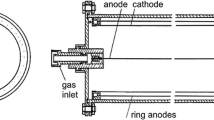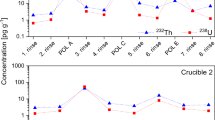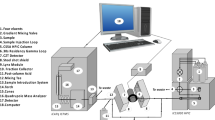Abstract
The most sensitive technologies for ultra-low-level analyses of long-lived radionuclides have been accelerator mass spectrometry and inductively coupled plasma mass spectrometry, reaching detection limits about 1 nBq/g. Together with underground operation of large volume HPGe detectors they have had great impact on underground physics experiments, approaching new frontiers in radioanalytics—a single atom counting.



Similar content being viewed by others
References
Arnold R et al (2010) Probing new physics models of neutrinoless double beta decay with SuperNEMO. Eur Phys J C 70:927–943
Agostini M et al (2016) Search of neutrinoless double beta decay with the GERDA experiment. Nucl Part Phys Proc 273–275:1876–1882
Abgrall N et al (2015) The Majorana Demonstrator neutrinoless double-beta decay experiment-Majorana Collaboration. Adv High Energy Phys 2014:365432
Angloher G et al (2014) EURECA conceptual design report. Phys Dark Univ 3:41–74
Angloher G et al (2017) CRESST collaboration. Eur Phys J C 77:637–645
Aprile E et al (2017) The XENON1T dark matter experiment. Eur Phys J C 77:881
Laubenstein M et al (2004) Underground measurements of radioactivity. Appl Radiat Isot 61:167–172
Povinec PP, Betti M, Jull AJT, Vojtyla P (2008) New isotope technologies in environmental physics. Acta Phys Slov 58:1–154
Budjáš D et al (2009) Gamma-ray spectrometry of ultra-low levels of radioactivity within the material screening program for the GERDA experiment. Appl Radiat Isot 67:755–758
Povinec PP (2012) New gamma-spectrometry technologies for environmental sciences. J Anal Sci Technol 3:42–71
Abgrall N et al (2016) The Majorana demonstrator radioassay program. Nucl Instrum Methods Phys Res A 828:22–36
Laubenstein M (2017) Screening of materials with high purity germanium detectors at the Laboratori Nazionali del Gran Sasso. Int J Mod Phys A 32:1743002
Povinec PP (2017) Background constraints of the SuperNEMO experiment for neutrinoless double beta-decay searches. Nucl Instrum Methods Phys Res A 845:398–403
Povinec PP (2018) Analysis of radionuclides at ultra-low levels: a comparison of low and high-energy mass spectrometry with gamma-spectrometry for radiopurity measurements. Appl Radiat Isot 126:26–30
Povinec PP (2018) New ultra-sensitive radioanalytical technologies for new science. J Radioanal Nucl Chem 316:893–931
Povinec PP et al (2018) Ultra-sensitive radioanalytical technologies for undergorund physics experiments. J Radioanal Nucl Chem 318:677–684
Povinec PP (2018) Developments in radioanalytics: from Geiger counters so single atom counting. J Radioanal Nucl Chem 318:1573–1585
Kaizer J, Dulanská S, Horváthová B, Povinec PP (2018) Development of separation procedures for determination of uranium and thorium in the 82Se source of the SuperNEMO experiment: first steps. J Radioanal Nucl Chem 318:2321–2327
Rakhimov AV et al (2019) Development of methods for the preparation of radiopure 82Se sources for the SuperNEMO neutrinoless double-beta decay experiment. Radiochim Acta. https://doi.org/10.1515/ract-2019-3129
Abgrall N et al (2017) The large enriched germanium experiment for neutrinoless double beta decay. AIP Conf Proc 1894:020027
Aprile E et al (2019) Observation of two-neutrino double electron capture in 124Se with XENON1T. Nature 568:532–535
Breier R, Brudanin VB, Loaiza P, Piquemal F, Povinec PP, Rukhadze E, RukhadzeV Stekl I (2018) Environmental radionu- clides as contaminants of HPGe gamma-ray spectrometers: Monte Carlo simulations for Modane underground laboratory. J Environ Radioact 190–191:134–140
Alimonti G et al (2009) The Borexino detector at the Laboratori Nazionali del Gran Sasso. Nucl Instr Meth Phys Res A 600:568–593
Belloti E, Cremonesi O, Fiorini E, Gervasio G, Povinec P, Ragazzi S, Rossi L, Sverzelatti PP, Szarka J, Tabarelli de Fatis T, Zanotti L (1992) Multielement proportional chamber—a study of background in the Gran Sasso underground laboratory. Nucl Instrum Methods Phys Res A323:125–134
Breier R, Laubenstein M, Povinec PP (2017) Monte Carlo simulation of background characteristics of a HPGe detector operating underground in the Gran Sasso National Laboratory. Appl Radiat Isot 126:188–190
Arnold R et al (2015) Results of the search for neutrinoless double beta-decay in 100Mo with the NEMO-3 experiment. Phys Rev D 92:072011
Arnold R et al (2018) Final results on 82Se double beta decay to the ground state of 82Kr from the NEMO-3 experiment. Eur Phys J C 78:821
Heusser G (1995) Low-radioactivity background techniques. Ann Rev Nucl Part Sci 45:543–590
Vojtyla P, Povinec PP (2000) A Monte Carlo simulation of background characteristics of low-level HPGe detectors. Appl Radiat Isot 53(1–2):185–190
Savvidis I et al (2010) Underground low flux neutron background measurements in LSM using a large volume (1 m3) spherical proportional counter. J Phys Conf Ser 203:012030
Ohsumi H et al (2002) Gamma-ray flux in the Fréjus underground laboratory measured with NaI detector. Nucl Instrum Methods Phys Res A 482:832–839
Palušová V, Breier R, Piquemal F, Povinec PP (2018) Monte Carlo simulation of environmental background sources of a HPGe detector operating in Modane underground laboratory. J Radioanal Nucl Chem 318:2329–2334
Loaiza P et al (2015) Obelix, a new low-background HPGe at Modane Underground Laboratory. AIP Conf Proc 1672(1):130002-1
Brudanin VB et al (2017) The low-background HPGe gamma- spectrometer OBELIX for the investigation of the double beta decay to excited states. IOSR-JAP 9:22–29
Breier R, Povinec PP (2009) Monte Carlo simulation of background characteristics of low-level gamma-spectrometers. J Radioanal Nucl Chem 282:799–820
Breier R, Povinec PP (2010) Simulation of background characteristics of low-level gamma-spectrometers using Monte Carlo method. Appl Radiat Isot 68:1231–1235
Breier R, Hamajima Y, Povinec PP (2016) Simulations of background characteristics of HPGe detectors operating underground using the Monte Carlo method. J Radioanal Nucl Chem 307:1957–196025
Agyriades J et al (2010) Results of the BiPo-1 prototype for radiopurity measurements for the SuperNEMO double beta decay source foils. Nucl Instrum Methods Phys Res A 622:120–128
Loaiza P et al (2017) The BiPo-3 detector. Appl Radiat Isot 123:54–59
Barabash A et al (2017) The BiPo-3 detector for the measurement of ultra-low natural radioactivities of thin materials. JINST 12:P06002
Jull AJT et al (2008) Accelerator mass spectrometry of long-lived light radionuclides. In: Povinec PP (ed) Analysis of environ- mental radionuclides. Elsevier, Amsterdam, pp 240–262
Povinec PP et al (2013) Cesium, iodine and tritium in NW Pacific waters—a comparison of the Fukushima impact with global fallout. Biogeosciences 10:5481–5496
Povinec PP et al (2017) Impact of the Fukushima accident on tritium, radiocarbon and radiocesium levels in seawater of the western North Pacific Ocean: a comparison with pre-Fukushima situation. J Environ Radioact 166:56–66
Kutschera W (2016) Accelerator mass spectrometry: state of the art and perspectives. Adv Phys 1:570–595
Ebser S et al (2019) 39Ar dating with small samples provides new key constrains on ocean ventilation. Nat Commun. https://doi.org/10.1038/s41467-018-074/5-7
Roos P (2008) Analysis of radionuclides using ICPMS. In: Povinec PP (ed) Analysis of environmental radionuclides. Elsevier, Amsterdam, pp 295–330
Nisi S et al (2009) Comparison of inductively coupled mass spectrometry and ultra-low-level gamma-ray spectroscopy for ultra-low background material selection. Appl Radiat Isot 67:828–832
LaFerriere BD et al (2015) A novel assay method for the trace determination of Th and U in copper and lead using inductively coupled plasma mass spectrometry. Nucl Instrum Methods Phys A 775:93–98
Lehto J, Hou X (2011) Chemistry and analysis of radionuclides. Wiley-VCH Verlag GmbH & Co. KGaA, Weinheim
Povinec PP et al (2015) A new IBA-AMS laboratory at the Comenius University in Bratislava (Slovakia). Nucl Instr Methods Phys Res B 342:321–326
Povinec PP et al (2015) Development of the accelerator mass spectrometry technology at the Comenius University in Bratislava. Nucl Instrum Methods Phys Res B 361:87–94
Povinec PP et al (2015) Joint Bratislava–Prague studies of radiocarbon and uranium in the environment using accelerator mass spectrometry and radiometric methods. J Radioanal Nucl Chem 304:67–73
Famulok N et al (2015) Ultrasensitive detection method for primordial nuclides in copper with accelerator mass spectrometry. Nucl Instrum Methods Phys B 361:193–196
Dalencourt C, Michaud A, Habibi A, Leblanc A, Larivière D (2018) Rapid, versatile and sensitive method for the quantification of radium in environmental samples through cationic extraction and inductively coupled plasma mass spectrometry. J Anal Atom Spec 33:1031–1040
Douglas DJ, Frank AJ, Mao DM (2005) Linear ion traps in mass spectrometry. Mass Spec Rev 24:1–29
Dehmelt HG (1969) Radiofrequency spectroscopy of stored ions. Adv Atom Mol Phys 5:109–154
Blaum K (2006) High-accuracy mass spectrometry with stored ions. Phys Rep 425:1–78
Alanssari M, Frekers D, Eronen T, Canete L, Gorelov D, Hakala J, Haaranen M, Holl M, Jeskovsky M, Jokinen A, Kankainen A, Koponen J, Mayer J, Moore ID, Nesterenko D, Pohjalainen I, Povinec P, Reinikainen J, Rinta-Antila S, Srivastava P, Suhonen J, Thompson R, Voss A, Wieser M (2016) Single and double beta-decay Q-values among the triplet 96Zr, 96Nb, and 96Mo. Phys Rev Lett 116:072501
Eronen T et al (2012) JYFLTRAP: a Penning trap for precision mass spectroscopy and isobaric purification. Eur Phys J A 48:46
Moore ID et al (2013) Towards commissioning the new IGISOL-4 facility. Nucl Instrum Methods Phys Res B 317:208–213
Petricca F (2019) First results on low-mass dark matter from the CRESST-III experiment. arXiv:1711.07692v1
Acknowledgements
Many colleagues participated in various stages of developments of radioanalytical methods for radiopurity investigations. These studies were triggered by development of low-level proportional counters for 3H and 14C counting in early seventies, which were in early nineties enlarged to multielement proportional chambers used for investigation of double beta-decay of 136Xe with groups of Prof. E. Fiorini in Gran Sasso and late Prof. A. Pomansky in Baksan underground laboratories. Later, our participation in new underground experiments for investigations of double beta-decay (NEMO-3), and especially searches for neutrinoless double beta decay (experiments SuperNEMO and LEGEND), as well as searches for dark matter particles (experiments EURECA and CRESST) stressed necessity of radiopure materials for construction of underground detectors. Except of many colleagues participating in the above-mentioned experiments, it has been a great privilege to work with my friends, distinguished scientists from all over the world. I would like to acknowledge recent collaboration with some of them (to mention at least the leaders of the groups participating in joint projects), namely L. Benedik (JSI, Ljubljana), M. Clemenza (INFN, Milano), D. Degering (VKAR, Dresden), D. Frekers (UniMünster), Y. Hamajima (UniKanazawa), M. Hult (IRMM, Geel), J. Kučera (INP CAS, Řež), D. Larivière (Université Laval, Québec), M. Laubenstein (GSNL, Assergi), S.H. Lee (KRISS, Daejeon), J.W. Mietelski (HNINP, Kraków), S. Nisi (GSNL, Assergi), M.K. Pham (IAEA-EL, Monaco), H. Simgen (MPIK, Heidelberg), F. Terrasi (UniCaserta), P. Steier (UniVienna). I am also indebted to many colleagues and graduated students in my CENTA team and at the Department of Nuclear Physics and Biophysics (R. Breier, M. Ješkovský, J. Kaizer, I. Kontul’, A. Kováčik, V. Palušová, J. Pánik, J. Staníček, J. Szarka, I. Sýkora, J. Zeman), as well as to S. Dulanská (Faculty of Natural Sciences of the Comenius University), for fruitful collaboration on recent developments of radiometric and accelerator mass spectrometry techniques for low-level radionuclide analyses. The developments of ultra-sensitive radioanalytical technologies and their applications at the Comenius University in Bratislava have recently been supported by the EU Research and Development Operational Program funded by the ERDF (Projects 26240120012, 26240120026 and 26240220004), by the International Atomic Energy Agency (Projects SLR 0/008, SLR 0/009, SLR1001), by the Slovak Research and Development Agency (Project APVV 15-0576) and by the Scientific Granting Agency of Slovakia (Projects VEGA 1/0891/17 and 1/0783/14).
Author information
Authors and Affiliations
Corresponding author
Additional information
Publisher's Note
Springer Nature remains neutral with regard to jurisdictional claims in published maps and institutional affiliations.
Rights and permissions
About this article
Cite this article
Povinec, P.P. Ultra-sensitive radionuclide analyses: new frontiers in radioanalytics. J Radioanal Nucl Chem 322, 1247–1255 (2019). https://doi.org/10.1007/s10967-019-06707-2
Received:
Published:
Issue Date:
DOI: https://doi.org/10.1007/s10967-019-06707-2




